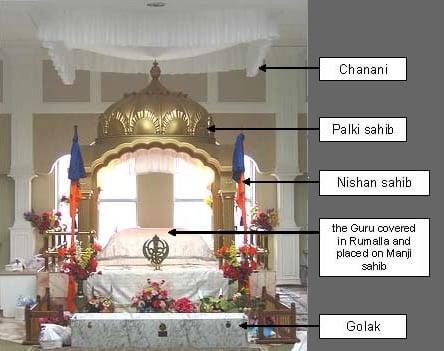Chanani: Difference between revisions
From SikhiWiki
Jump to navigationJump to search
Hari singh (talk | contribs) (New page: '''Chanani''' is a canopy normally made of highly decorated cloth which covers the scriptures as is used as a mark of respect. The platform where the Guru Granth sahib is placed the the [[...) |
Hari singh (talk | contribs) No edit summary |
||
| (4 intermediate revisions by 2 users not shown) | |||
| Line 1: | Line 1: | ||
' | [[Image:Guru's throne w captions v2.jpg|thumb|right|500px|Chanani and other features of the Guru's throne. (''click to enlarge'')]] | ||
The '''Chanani''' is a canopy, normally made of highly decorated cloth, which covers the SGGS when it is installed in a Gurdwara. It is usually attached high above the Guru's seat, secured to the ceiling or mounted on four posts. | |||
When in transit from its seat in the Gurdwara to its place of repose a palki with an attached Chanani is used. The covering is representative of the high respect afforded the Guru Granth Sahib and is used in the same way it was used in the Days of the living 10 Nanaks, in the Guru's Darbar. | |||
==See also== | |||
* [[Gurdwara]] | |||
* [[Palki]] | |||
* [[Manji sahib]] | |||
* [[Rumalla]] | |||
* [[Chaur]] | |||
{{term}} | {{term}} | ||
Latest revision as of 00:13, 28 February 2009
The Chanani is a canopy, normally made of highly decorated cloth, which covers the SGGS when it is installed in a Gurdwara. It is usually attached high above the Guru's seat, secured to the ceiling or mounted on four posts.
When in transit from its seat in the Gurdwara to its place of repose a palki with an attached Chanani is used. The covering is representative of the high respect afforded the Guru Granth Sahib and is used in the same way it was used in the Days of the living 10 Nanaks, in the Guru's Darbar.

